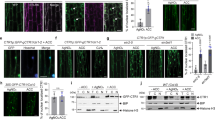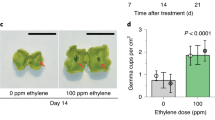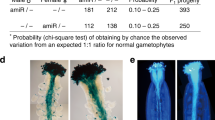Abstract
Ethylene gas is used as a hormone by plants, in which it acts as a critical growth regulator. Its synthesis is also rapidly evoked in response to a variety of biotic and abiotic stresses1,2. The Arabidopsis ethylene-overproducer mutants eto2 and eto3 have previously been identified as having mutations in two genes, ACS5 and ACS9, respectively; these encode isozymes of 1-aminocyclopropane-1-carboxylic acid synthase (ACS), which catalyse the rate-limiting step in ethylene biosynthesis3,4. Here we report that another ethylene-overproducer mutation, eto1, is in a gene that negatively regulates ACS activity and ethylene production. The ETO1 protein directly interacts with and inhibits the enzyme activity of full-length ACS5 but not of a truncated form of the enzyme, resulting in a marked accumulation of ACS5 protein and ethylene. Overexpression of ETO1 inhibited induction of ethylene production by the plant growth regulator cytokinin, and promoted ACS5 degradation by a proteasome-dependent pathway. ETO1 also interacts with CUL3, a constituent of ubiquitin ligase complexes in which we propose that ETO1 serves as a substrate-specific adaptor protein. ETO1 thus has a dual mechanism, inhibiting ACS enzyme activity and targeting it for protein degradation. This permits rapid modulation of the concentration of ethylene.
This is a preview of subscription content, access via your institution
Access options
Subscribe to this journal
Receive 51 print issues and online access
$199.00 per year
only $3.90 per issue
Buy this article
- Purchase on Springer Link
- Instant access to full article PDF
Prices may be subject to local taxes which are calculated during checkout




Similar content being viewed by others
References
Kende, H. Ethylene biosynthesis. Annu. Rev. Plant Physiol. Plant Mol. Biol. 44, 283–307 (1993)
Wang, K. L., Li, H. & Ecker, J. R. Ethylene biosynthesis and signaling networks. Plant Cell 14, S131–S151 (2002)
Vogel, J. P. et al. Recessive and dominant mutations in the ethylene biosynthetic gene ACS5 of Arabidopsis confer cytokinin insensitivity and ethylene overproduction, respectively. Proc. Natl Acad. Sci. USA 95, 4766–4771 (1998)
Chae, H. S., Faure, F. & Kieber, J. J. The eto1, eto2, and eto3 mutations and cytokinin treatment increase ethylene biosynthesis in Arabidopsis by increasing the stability of ACS protein. Plant Cell 15, 545–559 (2003)
Yang, S. F. & Hoffman, N. E. Ethylene biosynthesis and its regulation in higher plants. Annu. Rev. Plant Physiol. Plant Mol. Biol. 35, 155–189 (1984)
Bleecker, A. B. & Kende, H. Ethylene: a gaseous signal molecule in plants. Annu. Rev. Cell Dev. Biol. 16, 1–18 (2000)
Spanu, P. et al. The apparent turnover of 1-aminocyclopropane-1-carboxylate synthase in tomato cells is regulated by protein phosphorylation and dephosphorylation. Plant Physiol. 106, 529–535 (1994)
Guzman, P. & Ecker, J. R. Exploiting the triple response of Arabidopsis to identify ethylene-related mutants. Plant Cell 2, 513–523 (1990)
Roman, G. et al. Genetic analysis of ethylene signal transduction in Arabidopsis thaliana: five novel mutant loci integrated into a stress response pathway. Genetics 139, 1393–1409 (1995)
Kieber, J. J. et al. CTR1, a negative regulator of the ethylene response pathway in Arabidopsis, encodes a member of the raf family of protein kinases. Cell 72, 427–441 (1993)
D'Andrea, L. D. & Regan, L. TPR proteins: the versatile helix. Trends Biochem. 28, 655–662 (2003)
Collins, T., Stone, J. R. & Williams, A. J. All in the family: the BTB/POZ, KRAB, and SCAN domains. Mol. Cell. Biol. 21, 3609–3615 (2001)
Lizada, M. C. & Yang, S. F. A simple and sensitive assay for 1-aminocyclopropane-1-carboxylic acid. Anal. Biochem. 100, 140–145 (1979)
Tarun, A. S., Lee, J. S. & Theologis, A. Random mutagenesis of 1-aminocyclopropane-1-carboxylate synthase: a key enzyme in ethylene biosynthesis. Proc. Natl Acad. Sci. USA 95, 9796–9801 (1998)
Tsuchisaka, A. & Theologis, A. Heterodimeric interactions among the 1-amino-cyclopropane-1-carboxylate synthase polypeptides encoded by the Arabidopsis gene family. Proc. Natl Acad. Sci. USA 101, 2275–2280 (2004)
Hershko, A. & Ciechanover, A. The ubiquitin system. Annu. Rev. Biochem. 67, 425–479 (1998)
Hellmann, H. & Estelle, M. Plant development: regulation by protein degradation. Science 297, 793–797 (2002)
Xu, L. et al. BTB proteins are substrate-specific adaptors in an SCF-like modular ubiquitin ligase containing CUL-3. Nature 425, 316–321 (2003)
Pintard, L. et al. The BTB protein MEL-26 is a substrate-specific adaptor of the CUL-3 ubiquitin-ligase. Nature 425, 311–316 (2003)
Geyer, R. et al. BTB/POZ domain proteins are putative substrate adaptors for cullin 3 ubiquitin ligases. Mol. Cell 12, 783–790 (2003)
Furukawa, M. et al. Targeting of protein ubiquitination by BTB-Cullin 3-Roc1 ubiquitin ligases. Nature Cell Biol. 5, 1001–1007 (2003)
Kobe, B. & Kemp, B. E. Active site-directed protein regulation. Nature 402, 373–376 (1999)
Capitani, G. et al. Structure of 1-aminocyclopropane-1-carboxylate synthase, a key enzyme in the biosynthesis of the plant hormone ethylene. J. Mol. Biol. 294, 745–756 (1999)
Tarun, A. S. & Theologis, A. Complementation analysis of mutants of 1-aminocyclopropane-1-carboxylate synthase reveals the enzyme is a dimer with shared active sites. J. Biol. Chem. 273, 12509–12514 (1998)
Potuschak, T. et al. EIN3-dependent regulation of plant ethylene hormone signaling by two Arabidopsis F box proteins: EBF1 and EBF2. Cell 115, 679–689 (2003)
Guo, H. & Ecker, J. R. Plant responses to ethylene gas are mediated by SCFEBF1/EBF2-dependent proteolysis of EIN3 transcription factor. Cell 115, 667–677 (2003)
Tatsuki, M. & Mori, H. Phosphorylation of tomato 1-aminocyclopropane-1-carboxylic acid synthase, LE-ACS2, at the C-terminal region. J. Biol. Chem. 276, 28051–28057 (2001)
Yamagami, T. et al. Biochemical diversity among the 1-amino-cyclopropane-1-carboxylate synthase isozymes encoded by the Arabidopsis gene family. J. Biol. Chem. 278, 49102–49112 (2003)
Yamada, K. et al. Empirical analysis of transcriptional activity in the Arabidopsis genome. Science 302, 842–846 (2003)
Liu, Q. et al. The univector plasmid-fusion system, a method for rapid construction of recombinant DNA without restriction enzymes. Curr. Biol. 8, 1300–1309 (1998)
Acknowledgements
We thank members of the Ecker laboratory for stimulating discussion; J. Chory, J. Umen, S. Liljegren and J. Borevitz for critical reading of the manuscript; T. Hirayama for providing F2 seeds of the mapping cross; and A. Theologis for the JAde6 strain. K.L.-C.W. acknowledges support from a fellowship from the Pioneer Foundation. H.Y. acknowledges support from a long-term fellowship from the Japanese Science and Technology Agency. C.L. acknowledges support from a long-term fellowship from the Human Frontier Science Program. This research was supported by grants from the Department of Energy and the National Science Foundation to J.R.E.
Author information
Authors and Affiliations
Corresponding author
Ethics declarations
Competing interests
The authors declare that they have no competing financial interests.
Supplementary information
Supplementary Information
Contains supplementary data, methods, note, and figure legend. (DOC 24 kb)
Supplementary Figure 1
Alignment of ETO1 and EOL amino acid sequences. (JPG 255 kb)
Rights and permissions
About this article
Cite this article
Wang, KC., Yoshida, H., Lurin, C. et al. Regulation of ethylene gas biosynthesis by the Arabidopsis ETO1 protein. Nature 428, 945–950 (2004). https://doi.org/10.1038/nature02516
Received:
Accepted:
Issue Date:
DOI: https://doi.org/10.1038/nature02516
This article is cited by
-
Ethylene signaling modulates Arabidopsis thaliana nitrate metabolism
Planta (2022)
-
Emerging roles of the ubiquitin–proteasome pathway in enhancing crop yield by optimizing seed agronomic traits
Plant Cell Reports (2022)
-
CUL3 E3 ligases in plant development and environmental response
Nature Plants (2021)
-
Fruit quality and DNA methylation are affected by parental order in reciprocal crosses of tomato
Plant Cell Reports (2021)
-
Insights into the genes involved in the ethylene biosynthesis pathway in Arabidopsis thaliana and Oryza sativa
Journal of Genetic Engineering and Biotechnology (2020)
Comments
By submitting a comment you agree to abide by our Terms and Community Guidelines. If you find something abusive or that does not comply with our terms or guidelines please flag it as inappropriate.



